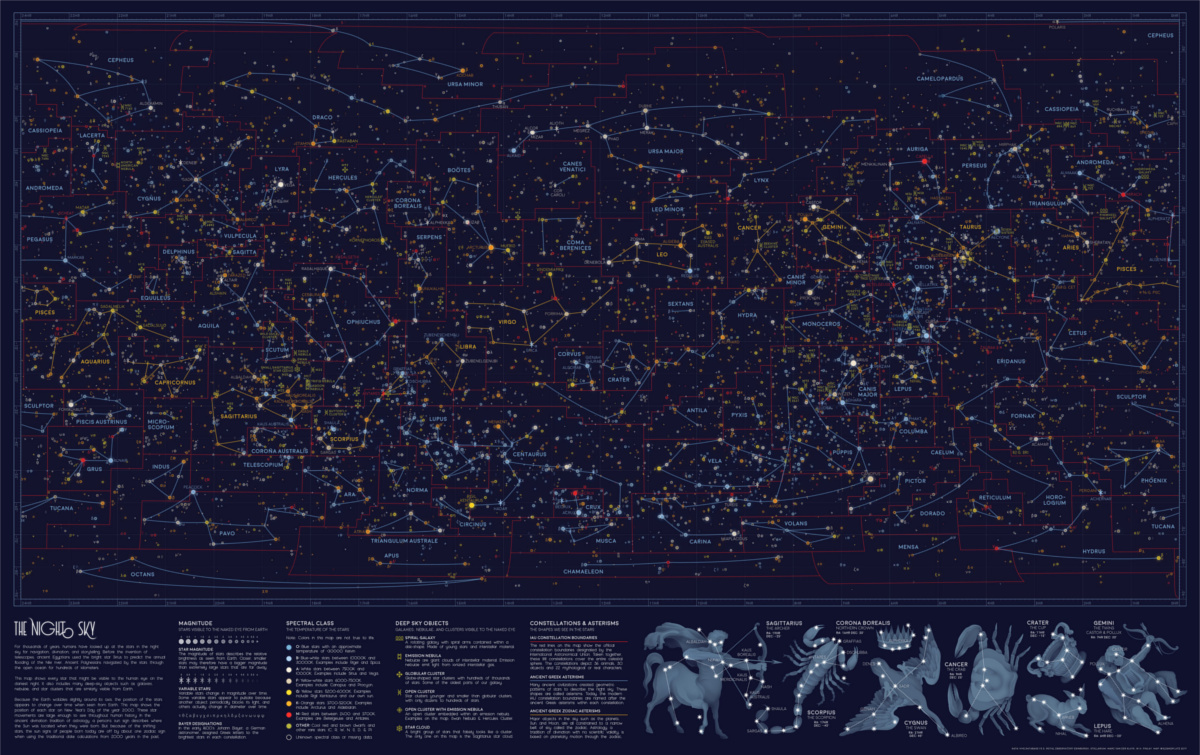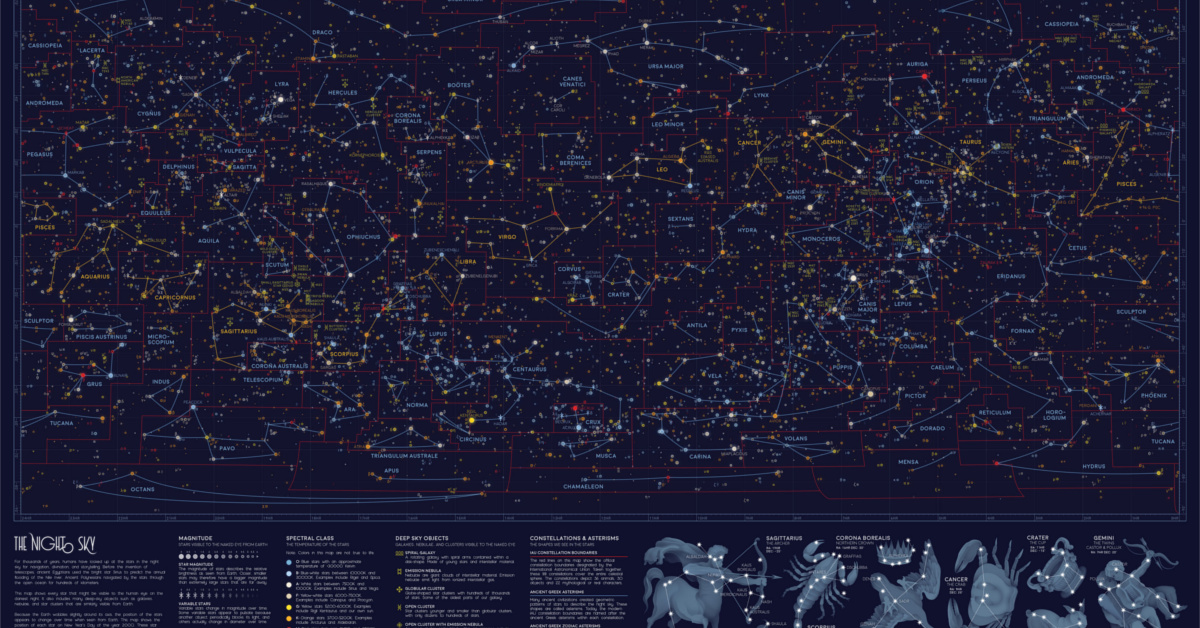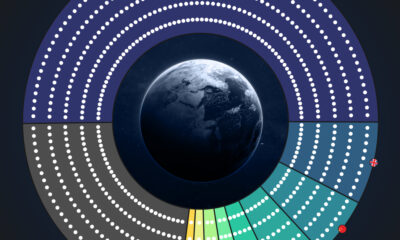Misc
Every Visible Star in the Night Sky, in One Map
View the full-size version of this infographic.
Every Visible Star in the Night Sky, in One Map
View the high resolution version of this incredible map by clicking here.
The stars have fascinated humanity since the beginning of civilization, from using them to track the different seasons, to relying on them to navigate thousands of miles on the open ocean.
Today, travelers trek to the ends of the Earth to catch a glimpse of the Milky Way, untouched by light pollution. However, if you’re in the city and the heavens align on a clear night, you might still be able to spot somewhere between 2,500 to 5,000 stars scattered across your field of vision.
This stunning star map was created by Eleanor Lutz, under the Reddit pseudonym /hellofromthemoon, and is a throwback to all the stars and celestial bodies that could be seen by the naked eye on Near Year’s Day in 2000.
Star Light, Star Bright
Stars have served as a basis for navigation for thousands of years. Polaris, also dubbed the North Star in the Ursa Minor constellation, is arguably one of the most influential, even though it sits 434 light years away.
Because of its relative location to the Earth’s axis, Polaris is reliably found in the same spot throughout the year—on this star map, it can be spotted in the top right corner. The Polynesian people famously followed the path of the North Star, along with wave currents, in all their way-finding journeys.
Interestingly, Polaris’ dependability is why it is commonly mistaken as the brightest star, but Sirius actually takes that crown—find it below the Gemini constellation, at the 7HR latitude and -20° longitude coordinates on the visualization. Located in the Canis Majoris constellation, Sirius burns bluish-white, and is one of the hottest objects in the universe with a surface temperature of 17,400°F (9,667°C). Sirius is nearly 40 times brighter than our Sun.
The Egyptians associated Sirius with the goddess Isis, and used its location to predict the annual flooding of the Nile. This also isn’t the only way humans have used visible stars to “predict” the future, as evidenced by the ancient practice of astrology.
Seeking Answers in the Stars
In the star map above, the orange lines denote the twelve signs of the Zodiac, each found roughly along the same band from 10° to -30° longitude. These Zodiac alignments, along with planetary movements, form the basis of astrology, which has been practiced across cultures to predict significant events. While the scientific method has widely demonstrated that astrology doesn’t hold much validity, many people still believe in it today.
The red lines on the visualization signify the constellations officially recognized by the International Astronomical Union (IAU) in 1922. Its ancient Greek origins are recorded on the same map as the blue lines, from which the modern constellation boundaries are based. Here’s a deeper dive into all 88 IAU constellations:
| Constellation | English Name | Category | Brightest star |
|---|---|---|---|
| Andromeda | Chained Maiden/ Princess | Creature/ Character | Alpheratz |
| Antlia | Air Pump | Object | α Antliae |
| Apus | Bird of Paradise | Animal | α Apodis |
| ♒ Aquarius | Water Bearer | Creature/ Character | Sadalsuud |
| Aquila | Eagle | Animal | Altair |
| Ara | Altar | Object | β Arae |
| ♈ Aries | Ram | Animal | Hamal |
| Auriga | Charioteer | Creature/ Character | Capella |
| Boötes | Herdsman | Creature/ Character | Arcturus |
| Caelum | Engraving Tool | Object | α Caeli |
| Camelopardalis | Giraffe | Animal | β Camelopardalis |
| ♋ Cancer | Crab | Animal | Tarf |
| Canes Venatici | Hunting Dogs | Animal | Cor Caroli |
| Canis Major | Great Dog | Animal | Sirius |
| Canis Minor | Lesser Dog | Animal | Procyon |
| ♑ Capricornus | Sea Goat | Creature/ Character | Deneb Algedi |
| Carina | Keel | Object | Canopus |
| Cassiopeia | Seated Queen | Creature/ Character | Schedar |
| Centaurus | Centaur | Creature/ Character | Rigil Kentaurus |
| Cepheus | King | Creature/ Character | Alderamin |
| Cetus | Sea Monster | Creature/ Character | Diphda |
| Chamaeleon | Chameleon | Animal | α Chamaeleontis |
| Circinus | Compass | Object | α Circini |
| Columba | Dove | Animal | Phact |
| Coma Berenices | Bernice's Hair | Creature/ Character | β Comae Berenices |
| Corona Australis | Southern Crown | Object | Meridiana |
| Corona Borealis | Northern Crown | Object | Alphecca |
| Corvus | Crow | Animal | Gienah |
| Crater | Cup | Object | δ Crateris |
| Crux | Southern Cross | Object | Acrux |
| Cygnus | Swan | Animal | Deneb |
| Delphinus | Dolphin | Animal | Rotanev |
| Dorado | Swordfish | Animal | α Doradus |
| Draco | Dragon | Creature/ Character | Eltanin |
| Equuleus | Little Horse | Animal | Kitalpha |
| Eridanus | River | Object | Achernar |
| Fornax | Furnace | Object | Dalim |
| ♊ Gemini | Twins | Creature/ Character | Pollux |
| Grus | Crane | Animal | Alnair |
| Hercules | Hercules | Creature/ Character | Kornephoros |
| Horologium | Pendulum Clock | Object | α Horologii |
| Hydra | Female Water Snake | Creature/ Character | Alphard |
| Hydrus | Male Water Snake | Creature/ Character | β Hydri |
| Indus | Indian | Creature/ Character | α Indi |
| Lacerta | Lizard | Animal | α Lacertae |
| ♌ Leo | Lion | Animal | Praecipua |
| Leo Minor | Lesser Lion | Animal | Regulus |
| Lepus | Hare | Animal | Arneb |
| Libra | Scales | Object | Zubeneschamali |
| Lupus | Wolf | Animal | α Lupi |
| Lynx | Lynx | Animal | α Lyncis |
| Lyra | Lyre | Object | Vega |
| Mensa | Table Mountain | Object | α Mensae |
| Microscopium | Microscope | Object | γ Microscopii |
| Monoceros | Unicorn | Creature/ Character | β Monocerotis |
| Musca | Fly | Animal | α Muscae |
| Norma | Carpenter's Square | Object | γ2 Normae |
| Octans | Octant | Object | ν Octantis |
| Ophiuchus | Serpent Bearer | Creature/ Character | Rasalhague |
| Orion | Hunter | Creature/ Character | Rigel |
| Pavo | Peacock | Animal | Peacock |
| Pegasus | Winged Horse | Creature/ Character | Enif |
| Perseus | Hero | Creature/ Character | Mirfak |
| Phoenix | Phoenix | Creature/ Character | Ankaa |
| Pictor | Painter's Easel | Object | α Pictoris |
| ♓ Pisces | Fishes | Animal | Alpherg |
| Piscis Austrinus | Southern Fish | Creature/ Character | Fomalhaut |
| Puppis | Stern | Object | Naos |
| Pyxis | Mariner's Compass | Object | α Pyxidis |
| Reticulum | Reticle (Eyepiece) | Object | α Reticuli |
| Sagitta | Arrow | Object | γ Sagittae |
| ♐ Sagittarius | Archer | Creature/ Character | Kaus Australis |
| ♏ Scorpius | Scorpion | Animal | Antares |
| Sculptor | Sculptor | Creature/ Character | α Sculptoris |
| Scutum | Shield | Object | α Scuti |
| Serpens | Serpent | Animal | Unukalhai |
| Sextans | Sextant | Object | α Sextantis |
| ♉ Taurus | Bull | Animal | Aldebaran |
| Telescopium | Telescope | Object | α Telescopii |
| Triangulum | Triangle | Object | Atria |
| Triangulum Australe | Southern Triangle | Object | β Trianguli |
| Tucana | Toucan | Animal | α Tucanae |
| Ursa Major | Great Bear | Animal | Alioth |
| Ursa Minor | Little Bear | Animal | Polaris |
| Vela | Sails | Object | γ2 Velorum |
| ♍ Virgo | Maiden | Creature/ Character | Spica |
| Volans | Flying Fish | Animal | β Volantis |
| Vulpecula | Fox | Animal | Anser |
(Source: International Astronomical Union)
Into the Depths of Deep Space
The quirk of naming stars after flora and fauna doesn’t end there. Our night sky also reveals visible galaxies, nebulae, and clusters far, far away—but they’re named after familiar birds, natural objects, and mythical creatures. See if you can find some of these interesting names:
- Open Cluster: Wild Duck Cluster
- Open Cluster: Eagle Nebula
- Open Cluster: Beehive Cluster
- Open Cluster: Butterfly Cluster
- Emission Nebula: North American
- Emission Nebula: Trifid Nebula
- Emission Nebula: Lagoon Nebula
- Emission Nebula: Orion Nebula
- Open Cluster with Emission Nebula: Swan Nebula
- Open Cluster with Emission Nebula: Christmas Tree Cluster
- Open Cluster with Emission Nebula: Rosette Nebula
- Globular Cluster: Hercules Cluster
There’s an interesting concentration of unnamed open and globular clusters just above the Sagittarius constellation, between 18-20HR latitude and -20° to -30° longitude. Another one can be seen next to Cassiopeia, just below Polaris between 1HR-3HR latitude, at 60° longitude. The only two visible spiral galaxies, Andromeda and Pinwheel, are located close between 0-2HR latitude and 30°-40° longitude.
The Relentless Passage of Time
We now know that the night sky isn’t as static as people used to believe. Although it’s Earth’s major pole star today, Polaris was in fact off-kilter by roughly 8° a few thousand years ago. Our ancestors saw the twin northern pole stars, Kochab and Pherkad, where Polaris is now.
This difference is due to the Earth’s natural axial tilt. Eight degrees may not seem like much, but because of this angle, the constellations we gaze at today are the same, yet completely different from the ones our ancestors looked up at.
If you liked exploring this star map, be sure to check out the geology of Mars from the same designer.
VC+
VC+: Get Our Key Takeaways From the IMF’s World Economic Outlook
A sneak preview of the exclusive VC+ Special Dispatch—your shortcut to understanding IMF’s World Economic Outlook report.

Have you read IMF’s latest World Economic Outlook yet? At a daunting 202 pages, we don’t blame you if it’s still on your to-do list.
But don’t worry, you don’t need to read the whole April release, because we’ve already done the hard work for you.
To save you time and effort, the Visual Capitalist team has compiled a visual analysis of everything you need to know from the report—and our upcoming VC+ Special Dispatch will be available exclusively to VC+ members on Thursday, April 25th.
If you’re not already subscribed to VC+, make sure you sign up now to receive the full analysis of the IMF report, and more (we release similar deep dives every week).
For now, here’s what VC+ members can expect to receive.
Your Shortcut to Understanding IMF’s World Economic Outlook
With long and short-term growth prospects declining for many countries around the world, this Special Dispatch offers a visual analysis of the key figures and takeaways from the IMF’s report including:
- The global decline in economic growth forecasts
- Real GDP growth and inflation forecasts for major nations in 2024
- When interest rate cuts will happen and interest rate forecasts
- How debt-to-GDP ratios have changed since 2000
- And much more!
Get the Full Breakdown in the Next VC+ Special Dispatch
VC+ members will receive the full Special Dispatch on Thursday, April 25th.
Make sure you join VC+ now to receive exclusive charts and the full analysis of key takeaways from IMF’s World Economic Outlook.
Don’t miss out. Become a VC+ member today.
What You Get When You Become a VC+ Member
VC+ is Visual Capitalist’s premium subscription. As a member, you’ll get the following:
- Special Dispatches: Deep dive visual briefings on crucial reports and global trends
- Markets This Month: A snappy summary of the state of the markets and what to look out for
- The Trendline: Weekly curation of the best visualizations from across the globe
- Global Forecast Series: Our flagship annual report that covers everything you need to know related to the economy, markets, geopolitics, and the latest tech trends
- VC+ Archive: Hundreds of previously released VC+ briefings and reports that you’ve been missing out on, all in one dedicated hub
You can get all of the above, and more, by joining VC+ today.
-

 Markets1 week ago
Markets1 week agoRanked: The Largest U.S. Corporations by Number of Employees
-

 Green3 weeks ago
Green3 weeks agoRanked: Top Countries by Total Forest Loss Since 2001
-

 Money2 weeks ago
Money2 weeks agoWhere Does One U.S. Tax Dollar Go?
-

 Automotive2 weeks ago
Automotive2 weeks agoAlmost Every EV Stock is Down After Q1 2024
-

 AI2 weeks ago
AI2 weeks agoThe Stock Performance of U.S. Chipmakers So Far in 2024
-

 Markets2 weeks ago
Markets2 weeks agoCharted: Big Four Market Share by S&P 500 Audits
-

 Real Estate2 weeks ago
Real Estate2 weeks agoRanked: The Most Valuable Housing Markets in America
-

 Money2 weeks ago
Money2 weeks agoWhich States Have the Highest Minimum Wage in America?
















